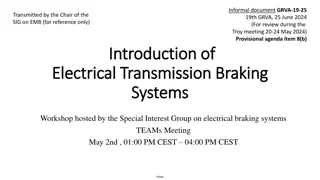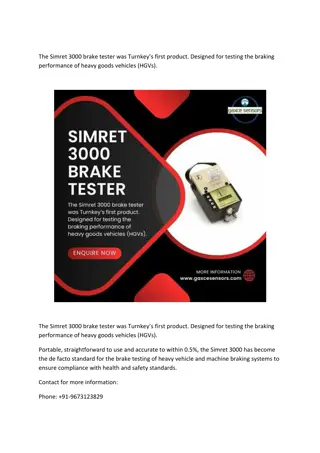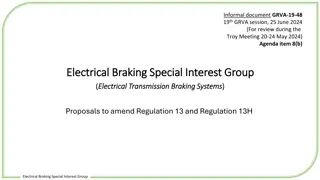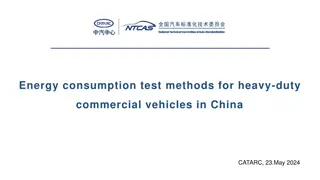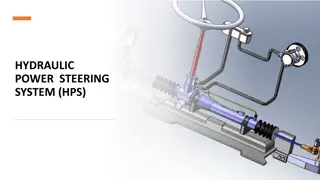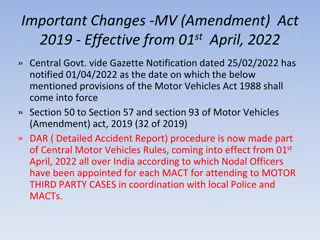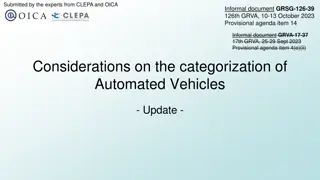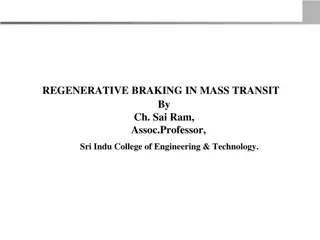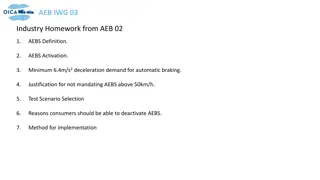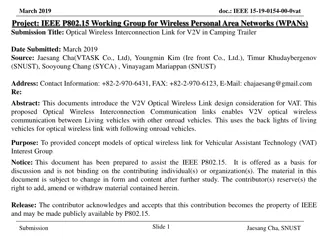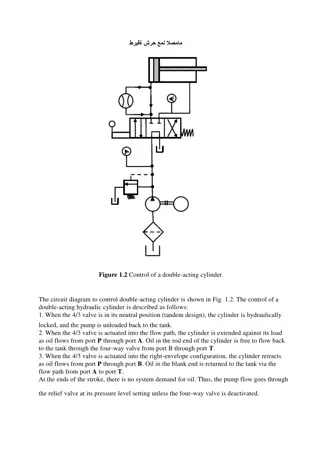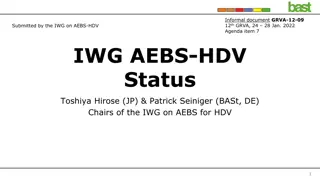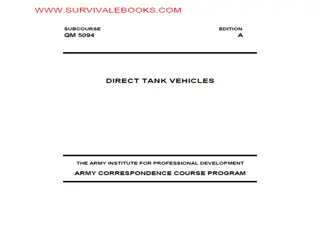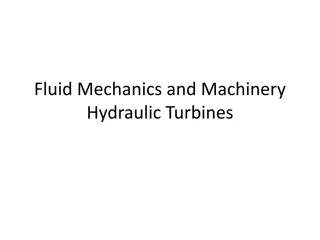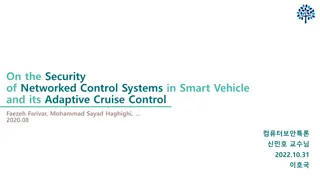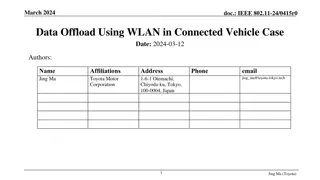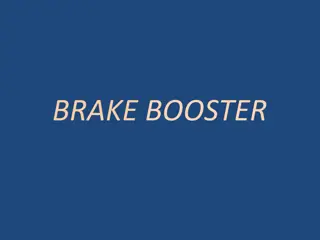Hydraulic Braking Systems in Vehicles
Hydraulic braking systems play a crucial role in controlling the speed and stopping vehicles safely. Components such as master cylinders, tandem cylinders, and vacuum servo units work together to ensure efficient braking performance. The system's construction includes calibrated springs and outlet valves, with different mechanisms for drum and disc brakes. When brakes are applied, pressure is built up in the system to actuate the brakes on the wheels. Understanding these key components and operations is essential for proper maintenance and troubleshooting of hydraulic braking systems.
Download Presentation

Please find below an Image/Link to download the presentation.
The content on the website is provided AS IS for your information and personal use only. It may not be sold, licensed, or shared on other websites without obtaining consent from the author.If you encounter any issues during the download, it is possible that the publisher has removed the file from their server.
You are allowed to download the files provided on this website for personal or commercial use, subject to the condition that they are used lawfully. All files are the property of their respective owners.
The content on the website is provided AS IS for your information and personal use only. It may not be sold, licensed, or shared on other websites without obtaining consent from the author.
E N D
Presentation Transcript
HYDRAULIC BRAKING SYSTEM Hydraulic brakes Master cylinder (Parts & Operation) Vacuum servo unit (purpose & operation) ABS braking system (basic lay-out and operation)
Master cylinder (Parts & Operation) Tandem master cylinder: A braking system is used to decrease the speed of the vehicle or to bring it to a halt. Braking action on the road wheels of a vehicle is normally achieved by means of hydraulic braking system. This is a dual-type brake master cylinder, one section serves the brake system to the front wheels while the second system serves the rear wheels. If there is a leakage in one of the systems, the second system will develop sufficient braking power to stop the motor vehicle within the safe distance. A warning light is mounted on the dashboard to warn the driver should any of the system become defective
Hydraulic brakes cont Construction: The tension of the primary calibrated springs is less than that of the secondary spring. When brake drums are used in both systems, both outlet ports are equipped with outlet- and - return valves to maintain a predetermined pressure in the brake system. When one of the system is equipped with disc brakes, the aforementioned valve is omitted in that specific system. The reason for this design is that no springs for returning the brake shoes are used in the disc system and it is only the spring property of the rubber seals which force the piston back slightly. If a valve is used in disc brake system, the pressure will not be relieved sufficiently.
Hydraulic brake cont When brakes are applied: The pushrod forces the primary piston towards the front The primary washer on the primary piston shuts off the relief port and pressure builds up between the pistons The secondary piston moves forward and the secondary washer shuts off the relief port in the section as well Further movement of the brake pedal and pushrod increases the pressure in both sections and this pressure is transmitted to the brake fluid in the pipes and wheel cylinders
Hydraulic brakes cont Should the system that is connected to the rear pressure chamber fails, the primary piston will move up against the secondary piston. The pistons move forward as a unit and pressure builds up in the front pressure chamber. In this case excessive movement of the brake pedal will be experienced This will be the same if front pressure chamber fails.
Hydraulic brakes cont When brakes are released: During the release of the brakes, the operation is identical to that of the single type brake master cylinder, depending on whether the combined valve is used or not. Functions of the port in the cylinder piston: It serves as an opening so that the hydraulic system may be filled with brake fluid after repairs In the released position, the port remains open to relieve any pressure build-up in the system, preventing the brakes from being activated If the servo unit is inoperative, the brakes can still be used because the pressure from the brake master cylinder is transmitted through the port to the wheel cylinder
Hydraulic brakes cont Brake pedal free play: Brake pedal free play is needed to prevent binding of the brakes and overheating. Brakes will bind if the master cylinder piston is not allowed to return to its brake release position against the stop washer and circlip. The compensating port is not fully uncovered and the pressure in the master cylinder pressure chamber cannot be released. Excess volume of brake fluid must be able to return to the reservoir when the brakes are released. If brake pedal free play is not according to specifications, the master cylinder pushrod must be adjusted. A worn pedal bushing or weak return spring can affect the free play.
Hydraulic brakes cont Vacuum servo unit: It improve the efficiency of the brake system by increasing the force on the drums or discs with less force applied to the brake pedal. Construction: A brake servo system contains the following components: A vacuum cylinder housing a spring-loaded diaphragm, known as the brake booster The slave cylinder, from where pressure is transmitted to the wheel cylinder The valve unit with a control valve and an air valve, The control valve is activated by hydraulic pressure from the brake master cylinder
Hydraulic brakes conti Operation: Release position The control valve is open The air valve kept shut by the return spring and the vacuum Vacuum from the intake manifold is directly applied to the spring side of the diaphragm Simultaneously, vacuum from the intake manifold and through ports in the control valve is also applied to the rear side of the diaphragm With even pressure on both sides of the diaphragm, the return spring in the booster keeps the diaphragm in the released position
Hydraulic brakes cont Brake pedal applied: Pressure from the brake master cylinder activates the hydraulic plunger in the valve unit The control valve is closed while the air valve is opened Air under atmospheric pressure is admitted through the air valve to the rear of the diaphragm Vacuum from the inlet manifold is applied to the spring side of the diaphragm The pressure difference causes the diaphragm to move against the spring tension
Hydraulic brakes cont The diaphragm rod closes the port in the piston of the slave cylinder Further movement of the diaphragm causes pressure to build up in the slave cylinder, brake tubing and the wheel cylinder Brakes released after application: Pressure from the brake master cylinder on the hydraulic plunger in the valve unit is released The control valve is opened while the air valve is closed Vacuum from the intake manifold is applied to both side of the diaphragm The return spring in the booster forces the diaphragm to the released position
Hydraulic brakes cont The diaphragm rod opens the port in the piston of the slave cylinder The pressure on the wheel cylinder is relieved Simple testing of the servo unit: With the engine switched off, apply brakes several times. This operation displaces the vacuum from the intake manifold and the servo unit. Keep the brake pedal well applied while the engine is started If the servo unit is efficient, the brake pedal should drop slightly
Hydraulic brakes cont ABS brakes Introduction: In early 1980s, the first antilock brake system(ABS) was introduced in the motor industry in the United States. It was a safety feature to give motor vehicle drivers more control when braking. ABS uses microprocessor and individual wheel speed sensor to observe the brakes. Hydraulic control-valves for each brake circuit prevent skidding during emergency braking or when braking hard on wet, iicy or slippery surfaces
Hydraulic brakes cont Operation: Wheel-speed sensor monitor the rotary motion of each wheel When brakes are applied, the ABS microprocessor compares wheel speeds If one or more wheels are rotating more slowly than the others, the system energises control valves to isolate the affected brake circuit Brake pressure is held briefly and is then released before it is re- applied This cycle allows the wheel to recover traction and avoid skidding
Hydraulic brakes cont Advantages of ABS: No loss of directional stability while braking Steering control retained even during heavy braking, shortest possible braking distance and reduce tire wear Provide optimum braking with no loss of directional stability under widely varying conditions
Hydraulic brakes cont.. What influences the stopping distance of a car: The stopping distance of a car is influenced by a variety of factors, including weather conditions, road surface, prevailing traffic and the amount of brake pressure applied


